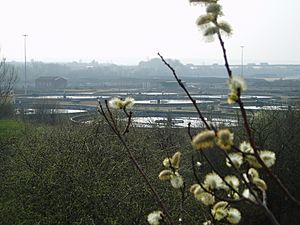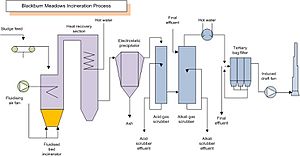Blackburn Meadows facts for kids
Quick facts for kids Blackburn Meadows |
|
|---|---|

The nature reserve, with the Magna Science Adventure Centre in the background
|
|
| Lua error in Module:Location_map at line 420: attempt to index field 'wikibase' (a nil value). | |
| Type | Waste Water Treatment Works |
| Location | Sheffield, South Yorkshire, England |
| Created | 1886 |
| Operated by | Yorkshire Water |
Blackburn Meadows is a special area of land in Sheffield, England, near a place called Tinsley. It's famous for being home to one of Britain's largest water treatment plants. This plant cleans the city's dirty water before it goes back into the River Don.
The treatment plant started way back in 1884. At first, the cleaning process was quite simple. Over time, it grew and improved a lot. During the First World War, a new cleaning method called "bio-aeration" was invented here. It became known as the "Sheffield System" and people from all over the world came to see it.
For over 100 years, the plant even had its own small railway! It used steam and diesel trains to move waste around. Today, the plant continues to improve water quality, helping fish and other wildlife return to the River Don. Part of the area has also been turned into a lovely nature reserve.
Contents
Blackburn Meadows: Cleaning Water for Sheffield
Blackburn Meadows is the lowest point in the Sheffield City Council area. The River Don flows out of the city here. This low spot made it a great place to build a sewage treatment plant. The Blackburn Meadows plant officially opened in 1886.
It is located north of the River Don and east of the Tinsley Viaduct. In 2006, it was said to be the second largest water treatment plant in the United Kingdom. It cleans about 79 million gallons (360,000 cubic metres) of dirty water every day!
How the Plant Started
As Sheffield grew, the city council bought land at Blackburn Meadows to build the water treatment plant. Construction began in 1884. A short railway track was built to connect the plant to the main railway line. The construction was finished by January 1886.
The Mayor of Sheffield officially opened the plant on June 2, 1886. At first, the dirty water flowed through special pits where solid bits could settle. Then, a substance called milk of lime was added to help clean the water. After more settling, the water went through filters and was then released into the river.
About 100 tons of sludge (the solid waste) were removed each day. This sludge was pumped into ponds to dry. Farmers sometimes used the dried sludge as fertiliser. Other times, it was taken by train to a tip at Kilnhurst, near Rotherham.
The plant's railway also grew. In 1898, the first steam train arrived. It was an 0-4-0 saddle tank engine. This train helped move materials and waste around the large site.
At the same time, large underground pipes called trunk sewers were built. These sewers carried dirty water from the city to the plant. By 1910, the sewer system was expanded to handle even more water. During heavy rain, some diluted dirty water would flow into the River Don.
Growing and Improving the Cleaning Process
People soon worried about the quality of the water being released into the River Don. The old cleaning process wasn't good enough. So, in 1900, Sheffield Corporation bought more land to build better treatment areas. They planned to build "contact beds" to clean the water more thoroughly.
New plans were approved in 1905 to build a biological treatment system. This was a big change from using lime. The new system included settling tanks and contact tanks. A bridge called Jordan Bridge was also built to carry the internal railway line over the River Don Navigation.
The first part of the new plant opened in 1909. But the water released into the river was still not clean enough. A second, even better, treatment process was planned. However, this was delayed by the start of the First World War.
In 1914, John Haworth became the works manager. He started experimenting with new ways to clean the water. He built a special narrow channel where paddles stirred the water. This added oxygen, which helped tiny helpful bacteria grow. These bacteria then "ate" the sewage, cleaning the water. This process was called bio-aeration, but it became famous as the "Sheffield System." Many people came to see this amazing new method.
Between 1922 and 1927, many of the old contact beds were changed to use this new system. The "Sheffield System" greatly improved the water quality. However, it wasn't very good at removing ammonia. High ammonia levels in the river meant that fish could not survive below the plant.
The plant's railway also got new trains. In 1918, a new steam engine arrived. During the 1926 general strike, this engine was allowed to run on the main railway line. It delivered wagons of waste to the Kilnhurst tip. This tip eventually became full in 1948, and a new tip opened at Thrybergh.
Modern Upgrades
The entire plant was upgraded between 1956 and 1969. This big project cost about £1 million. The first phase was building a filter pressing plant, which helped squeeze water out of the sludge. This was finished in 1962. Other phases included new settling tanks and a plant to separate storm water.
The railway also got an upgrade. New tracks were laid, and in 1960, a new diesel electric train arrived. It worked so well that a second one was ordered the next year. The old steam trains were eventually replaced or scrapped. The railway also got new steel wagons to replace the old wooden ones.
In 1976, another new diesel train was bought. It was even driven along the main railway line from Kilnhurst to the plant! The connection between the plant's railway and the main British Rail network was cut in 1984. This made it one of the few isolated standard gauge railways. The railway stopped operating in the 1990s. One of its wagons is now at the National Railway Museum at Shildon, and one of its trains is on the Peak Rail preserved railway.
By the 1960s, Sheffield's sewers were too small for all the dirty water. They often overflowed into the river, even when it wasn't raining heavily. To fix this, a huge new sewer called the Don Valley Interceptor Sewer was tunnelled deep underground. This project started in 1979.
Over the next ten years, several more phases of tunnelling were completed. This greatly increased the sewer's capacity. As a result, 26 storm sewage overflows into the river were closed. This made the water quality in the River Don much better.
Continuing Improvements
In 1992, a new system was built to reduce the amount of ammonia in the cleaned water. This was a huge step! It helped fish populations return to the lower River Don. The old sludge treatment and burning plants were also replaced with new, modern ones.
The new plant made the old sludge beds unnecessary. These old beds, located east of the River Don, have now become a nature reserve. Further improvements were made by 2005. These included upgrading the system that cleans gases from the incinerator. This ensures the plant meets strict environmental rules.
About £70 million has been invested in upgrading the plant. This makes sure that the water released into the river meets high standards for freshwater fish. In dry weather, the plant releases 30 million gallons (136,000 cubic metres) of treated water each day. This more than doubles the river's flow at this point!
On June 25, 2007, the plant had to shut down because the River Don burst its banks. The entire site was flooded for over a week, and much of the equipment was badly damaged. But the plant was quickly repaired and back in action in just 18 days!
In 2012, a new facility was built to treat sludge using a process called anaerobic digestion. This process uses tiny organisms to break down waste at moderate temperatures. The treated sludge can now be used as fertiliser on nearby farms. This new facility also helps Yorkshire Water create 1.9 megawatts of clean, renewable energy!
Blackburn Meadows Power Station
In 1921, a coal-fired power station was built at Blackburn Meadows. At that time, there was no national electricity grid. Steelworks in the area needed more power, and this site was perfect. It was close to the steelworks, near the river for cooling water, and had good railway access for coal.
The power station was upgraded between 1937 and 1942, increasing its power to 72 Megawatts. It operated until the 1980s. When most of the power station was taken down, two of its seven cooling towers remained. They were very close to the M1 motorway and the Tinsley Viaduct, so demolishing them was tricky.
These 250-foot-tall towers were built between 1937 and 1938. They were designed by L. G. Mouchel and Partners. On August 24, 2008, at 3 AM, the two famous towers were finally demolished using explosives. They were taken down safely without damaging the motorway.
In 2011, Sheffield City Council started building a new biomass power station at Blackburn Meadows. This station, operated by E.ON UK, was finished in 2014. It creates 30 megawatts of electricity by burning waste wood from the United Kingdom. It also captures waste heat to provide heating for local buildings.
Nature Reserve
In 1993, Sheffield City Council and Yorkshire Water worked together. They agreed to turn an unused part of the old water treatment plant into a nature reserve. The council leased the land for 99 years for a very small annual payment.
A group was formed to manage the project, including Sheffield City Council, Sheffield Wildlife Trust, South Yorkshire Forest, and Yorkshire Water. This area now provides a home for many migrating birds. It is very important for birds in Europe. The Wildlife Trust also runs school visits to teach children about nature here. In 2005, the City Council expanded the reserve by taking over more land from Yorkshire Water.
|




